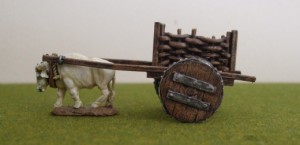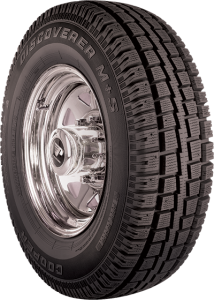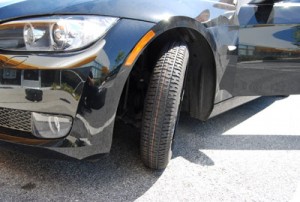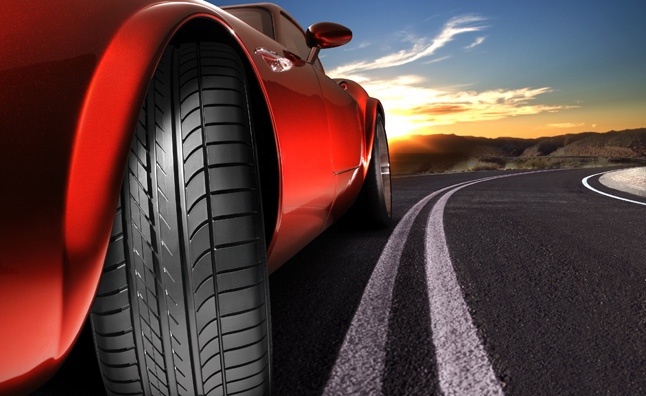The invention of the wheel was a pretty big deal – rolling stuff being a lot easier than carrying (or pushing or dragging) it.
The invention of tires was the next great leap forward. Rubber tires allowed wheels to travel more smoothly on rough/uneven surfaces and at faster-than-walking pace without shaking themselves – and the cart or carriage or (eventually) car to which they were bolted to pieces. They also much improved traction – getting you going on slick/slippery surfaces, laterally (in the corners) as well as when you want to slow down (many people do not realize that a set of good tires contributes mightily to shorter stopping distances).
Ultimately, they’re the last thing between you and the road. So it’s a good idea to know a few things about them. Such as the fact that…
* Tires age –
Many people assume that if the tread still looks good, the tires are ok. Not necessarily. A tire with 90 percent of its tread left may be close to 100 percent worn out – a failure just waiting to happen. And if it happens at the wrong moment – like when you’re doing 80 on the highway, for instance – it could have catastrophic consequences.
Tires, recall, are made of rubber. Well, rubber bonded with fabric and steel. Rubber loses its elasticity over time as a result of exposure to sun/ozone, which breaks down the rubber. It become less flexible; the tire may become brittle. If you look closely at the sidewall, especially near the rim, you may see small cracks that look like an old lady’s face with too much make-up. At that point the tire is potentially dangerous and ought to be replaced, regardless of the tread left.
Tire life has increased; anti-aging agents mixed with the rubber have helped stave off dry-rot such that tires now last 2-3 times as long as they did back in the ’70s. But they’re not immortal.
Entropy is a mean – and inescapable – bitch.
As a general rule, modern tires more than ten years old should be replaced even if no obvious signs of wear (such as cracking along the sidewall) are evident, especially if the vehicle is going to be used regularly and particularly if it is going to be used for highway driving. So, if you buy a low-miles circa 2005 car that’s mostly just been sitting for the previous six years and so still has its factory original tires, you probably ought to buy a new set, no matter how “new” the tires look.
Lower the interval to six years from date of manufacturer (the data is stamped on the tire’s sidewall; see here for where) if the tires are high-performance/high-speed tires and you are planning to drive the car at high speeds (80 MPH or more) for sustained periods (more than a few minutes at a time) or subject them to high loading such as high-speed cornering. High-speed driving builds up heat – and even tires designed to handle that may no longer be able to safely handle that once they reach a certain age. In Europe – where sustained high-speed driving is legal – the recommended throw-away date is six years, no matter how much tread is left or how the tires look.
Any tire with a bubble or tear on the sidewall should be replaced ASAP regardless of tread or age. The tire may be structurally weak and a sudden blowout (rather than a gradual slow leak) could occur at speed, with an equally sudden loss of control.
To maximize tire life: When you buy, insist on new tires. Not tires that have been sitting on the shelf for the past year. Check the date code on the sidewall (see above link). Always maintain the recommended inflation pressure. And if the car is parked for long periods, move it at least every two weeks to avoid flat-spotting the tires. Rotate the tires per the manufacturers’ recommendations to even out the wear.
* Tires have different “personalities” –
Some are aggressive – designed to maximize the car’s cornering grip/sharpen steering responsiveness. They are built to cope with sustained high-speed operation … but usually, the heightened athleticism comes at the expense of ride quality and tread life.
Others are rugged – designed to be great when it snows and for romping around off road. But they’re less adroit on dry pavement – and can be obnoxiously noisy, too.
Others are softies – designed to give your car a very smooth/quiet ride… but they’re not the hot ticket for high-speed driving.
This is why most cars come from the factory wearing all-season tires that are a compromise design, balancing performance, handling/steering responsiveness with ride quality, tread life – and so on.
However, you might want to improve your vehicle’s handling – or its snow-day capabilities. Maybe you’d like a softer ride – and it’d be really nice if the tires lasted for 50,000 miles instead of 30,000 miles. Picking a different type of tire is a fairly easy way to fine-tune your car’s personality – and capabilities – to better suit the way you actually drive – and the way you’d like for the car to drive.
For example, if you have a pick-up truck, SUV or crossover, going with M/S (mud and snow) rated tires vs. factory all-seasons can dramatically improve your vehicle’s ability to not get stuck if you drive it onto a grassy (and wet and muddy) field, or when it snows. And if you’d like your sporty car to feel even sportier, going with a more aggressive “summer” tire will do exactly that.
Just be aware that improvements here may also result in liabilities there. High-performance “summer” tires, for example, are often as worthless in winter as a bikini in Antarctica. And M/S “knobbies” – though great in the snow – make a racket on dry pavement and will wear fast if you operate on the highway for extended periods.
You’ll want to have a chat with a tire professional before you change shoes.
* You probably haven’t got a spare – 
For a variety of reasons – to save weight (fuel economy pressures) and because many modern cars come with huge wheels/tires (hence a spare would take up most of the trunk) – many new cars either don’t have a spare tire at all or they come with a “space saver” spare.
Those without a spare at all have run-flat tires that can be driven on even if they’re punctured and lose all air pressure. The catch is that you may not notice a tire has run flat and if you continue to operate at high speed or subject the car to high-g loading (as when cornering at a speedy clip) you may be made aware of the problem the hard way. Cars with run-flats usually have a dash warning light to alert you to a low-pressure (or flat) situation. But warning lights (and gauges) do you no good if you’re not paying attention to them. If the light comes on – adjust your driving accordingly until you can get to an air pump (if the tire’s just low) or a tire shop (if the tire is damaged and needs to be replaced).
Space-saver tires, on the other hand, are not even really tires at all. They are definitely not equivalent to the tires normally at each of your car’s four corners. What they are is a stop-gap. A life preserver. A means to get the car rolling again – but just barely. Space-saver tires are specifically temporary use only (see the large yellow warnings on the rim). They are typically much smaller (not diameter but width) and this greatly – negatively – affects handling and braking performance. They are specifically not designed for sustained driving at even normal highway speeds. The recommendation is usually no faster than 55 MPH – and for short distances only. They are to get you to the nearest tire shop and avoid a tow truck. That’s it.
PS: If you get a flat, it might be fixable if the puncture damage is on the tread portion of the tire (sidewall damage cannot be repaired). However, high-speed/high-performance tires may no longer be sound for high-speed/high-performance driving once damaged – even if they could be repaired. Their structural integrity has been compromised. Usually, the tire’s manufacturer will have specific details about this.
Read/ask – and know.
If you value independent media, please support independent media. We depend on you to keep the wheels turning! Things are tight this month especially (please see here).
Our donate button is here.
If you prefer to avoid PayPal, our mailing address is:
EPautos
721 Hummingbird Lane SE
Copper Hill, VA 24079
PS: EPautos stickers are free to those who sign up for a $5 or more monthly recurring donation to support EPautos, or for a one-time donation of $10 or more. (Please be sure to tell us you want a sticker – and also, provide an address, so we know where to mail the thing!)











No. Iron tyres allowed wheels to travel more smoothly on rough/uneven surfaces and at faster-than-walking pace without shaking themselves – and the cart or carriage or (eventually) car to which they were bolted to pieces (and also to stop the felloes of the wheels from wearing out). Rubber ones delivered more of those benefits and the benefits of the last sentence quoted, but they weren’t necessary for the benefits of the second sentence quoted.
A lot of cars with no spare at all, don’t have run flats.
They come with gunk-in-a-can and an air-pump.
Volvo does this, nice safety there.
Any sort of sudden blow-out, like hitting pot-holes, can do damage that the gunk can’t fix.
Now, no choice but a tow truck.
Then try to find someone who has the one you need in stock. This will happen at night or on the weekend.
Volvo even has the courtesy to tell you that the gunk may very well damage the pressure sensor, so you get to buy that too (if you don’t want the annoying constant warning).
They give you a spare, if you ask for it at time of purchase, but they “forgot” to put a wheel well in the car, so that has to be tethered in the trunk, lol.
North East driver, 4 pot holes in 7 years, so this isn’t theory.
(the kind that wasn’t there last night, and almost cracked your spine, if not your axle…)
Thanks Eric for the information about finding the manufacturing date of the tire because I did not know that.
I would add that buyers should make sure that the tire installers use torque wrenches to evenly and correctly tighten lug nuts because _most_ installers use impact wrenches and seem to believe that tighter is always better so long as threads aren’t stripped. Most of us have probably driven vehicles that brakes pulsated when the pedal is pushed down. That happened because the lug nuts were overtightened which caused the brake rotors and/or aluminum wheels to warp. The manufacturers aren’t going to tell you to drive around with loose lug nuts for liability reasons, therefore; if they say to tighten the lugs to 85 psi: you are going to be safe. I bet most of you folks will find that your lug nuts are far, far tighter than that if you use a torque wrench to check them. Perhaps over 100 psi tighter.
Question: I have a 1/Rev sound coming from one of my tires – I can’t even tell which one. wha-wha-wha-wha-wha-wha-wha It showed up shortly after I bought 4 top of line 4 tires. (LTX – P225/70R16) I’ve had various mechanics look at it and they say they wish they had a set. The reliable outfit who rebuilt the transmission 5 weeks after I bought it says it’s tire noise and it’s not bearings. Suggestions?
Hi Ed,
This is one of those process of elimination situations. If the sound was not there prior to installing the new tires, I’d focus on the tires first.
One way to identify the tire that’s making the noise is to rotate all four and see whether that affects the sound. You may be able to at least isolate the problem to one side of the car (and thus, to two of the four).
You might go back to the tire shop and ask them to do this for you.
Also, with the car on a rack, it is very easy to check the condition of the wheel bearings and at least eliminate that as a potential issue.
Thank you, Sir. Actually the place I bought the car from had one of their locations install new tires just before I took possession. I thought I couldn’t go wrong buying a car from a reputable repair facility which used only certified techs. After 20 years of my business, the transmission died five weeks later (they said it had been rebuilt just before they got it) but it only carried a 1 month dealer warrantee. The owner refused to stand behind it. Needless to say, I took my business elsewhere and the branch I used closed. I haven’t been back, but it was another lesson.
I very much appreciate all of your articles, except this particular one which tells me I probably have to replace the MXL’s I put on my ’65 356C years ago – even though it’s rarely been outdoors and hasn’t been registered since 1984… All the best.
My daughter has a 2015 Honda Pilot 2wd. Both she and her husband say it becomes unstable on wet roads, more than just normal hydroplaning. They both are experienced drivers. It has the factory Michelin tires. Wondering if it is tire related. Dealer says it not their problem. Any reports of similar experiences with this model?
Hi David,
Does this occur at normal/legal road speeds?
Yes. Mostly during rain. Even relatively light rain.
Hi David,
Thanks!
Ok, the first thing I’d check is inflation pressure. If the tires are over-inflated, they’ll tend to hydroplane sooner. There is probably a recommended range of pressures for this vehicle (and the tires). Have them try the lower end and see whether that helps.
The ride quality will probably improve some, too!
Thanks, we’ll give it a try. I enjoy your articles.
Size-ism has been added to the other deadly “isms” that are verboten.
eric, did you once have an article about tire life and the DOT numbers molded on any tire legal for highway use? I recall it from somewhere though. I also recall some entity going to different tire sellers and buying tires after which they’d look at the DOT number and determine how old the tires were when installed.
It was an eye-opener to say the least. Seems like Sears was the worst offender although not the only one, to sell tires that had been in stock for 6 years or longer.
Since that time I have kept a close watch on the date of manufacture when buying tires.
Yesterday, running down the interstate I had a fairly new Dodge dually(4WD)pass me and nearly knock my hearing out. The owner had gone to the new style of larger tires commonly seen on pickups these days. Of course the rear duals were very close to each other. I’d be interested to know how many miles those tires will last. By the sound of them they were probably a mud tire and the owner will find out what a bad choice it was for a pickup that will be used for highway in west Tx. The trend that started about 10 years ago of wrapping tread around on the sidewall for light truck tires has spread to countless brands now. Not only will 99.9% of those tires never be used in deep mud but having tread of any depth on the sidewall seems like asking for trouble. It would seem the last thing a street tire would have happen is for the sidewall to really get a grip on anything. A stone or stick is tough enough on a sidewall without the sidewall trying to get a grip.
I often see young women in obviously uncomfortable clothing and going to extremes to fit the fashion mold. Why should young men be any different?
Eric_G, ain’t it the truth? Those girls/women must see something different in the mirror than I do. A very tight shirt over their spare tires or multiple rolls is not flattering at all but instead of wearing something that makes them look slimmer, they continue to wear things(3-4 layers)that accentuate their fat. I know a lot of women too old for that look anyway that do this too and boy, does it NOT look good.
When I got out of high school I recall the girls of Ca. and like the song, most of them were pretty good looking but overall, they couldn’t compare to Texas women. Now they’re all fatties. Young men too.
I was recently at a drilling rig and went into the operations room. All these white guys had guts so big they had to squeeze past one another. Evidently food has surpassed the need for sex and everything else. Back when I was that age, the common roughneck was hard as a rock. Times have changed for sure. For sure you won’t see anyone riding the cat line to the derrick.
Eightsouthman,
The extra weight might break the back of the cat. Must be careful not to overload the system.
I’m giving it all she’s got.
😉
Remember when fat women wearing tight and skimpy was a topic of TV freak shows like “Jenny Jones”? Well now if you don’t like looking at it, not attracted to fat women, you’re the problem. At least that seems to be what is being pushed these days.
Hi 8,
The blame of the vast overweight epidemic of even the working people belongs, imo, to the use of high fructose corn syrup instead of real sugar in a great many of our processed food products. Even real sugar consumption should be consumed sparingly, but I invite you to read the ingredients of the processed foods to you are considering to purchase. You will find that nearly all cans of sweet potatoes, bottles of sweet tea and sodas, ketchup, and most other things contain that ingredient. Also, wheat has more gluten in it now-a-days than it used to; but wheat was never a real human food anyway.
Sure, not everyone who eats those foods are fat just like not everyone who chain smokes will die of lung cancer.
For these reasons: I have been switching to the caveman/paleolithic diet to the best of my limited ability in my present living environment. If you are interest in learning more details about the caveman diet; then a good starting place would be Mark’s Daily Apple:
http://www.marksdailyapple.com/welcome-to-marks-daily-apple/
Brian, thanks. I have been subscribed to Mark for several years. I talked the wife into going paleo nearly two years ago. It worked well for me but she cheats at work with a bunch of fatties who never quit eating bad food. I have a hard time following it being a trucker and often don’t eat anything during the day and then have something late at night when I get in. It’s played hell with gaining weight even though I try to keep it paleo.
I was always a bread guy having grown up with lots of home made bread. I managed to kick wheat entirely but now the wife is always showing up with some wheat based product.
I notice my allergies are much better with no wheat products as well. There’s only one thing I eat with sugar in it and that’s beer and I can drink a lot of it.
I rarely buy anything but water or lemonade or lemon water at the convenience store. Don’t do soft drinks of any sort either. Left to me, no bags of chips come home but the wife makes sure we have corn and tater chips. I try to stay away from them.
I juice a whole lemon every morning and drink it in 12-14 oz. of water with some stevia(or not).
As far as gluten goes, even brewers use it in beer. It’s hell to get away from if you eat any prepared food which I do my best to avoid.
It’s rare for me to hit a truck stop and only happens when I can’t find a tire repair or just stop and check a load, bump tires and use the restroom.
I sometimes get nauseous smelling the food in convenience stores and if it’s a common thing for one I avoid it. I have smell allergies too. Have a great nephew who can just walk through a room and instantly throw up if someone is wearing perfume. I have been known to get nauseous from scents too and have to use Free and Clear laundry detergent or I’ll break out.
I’ve lived away from home for years at a time and have to find some way to avoid using a laundromat because of the perfumes used in the various detergents and dryer towels. I also avoid any place I might encounter cigarette smoke so that keeps me in the fresh air and eating something I bring from home in the wide open or cab of a truck.
Last Friday I drove a truck for a friend and the former driver had one of those scent things in the a/c register. I was sick to my stomach for a while and realized what was causing it so I littered right then and there.